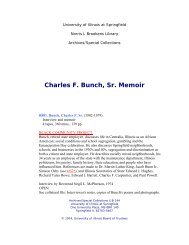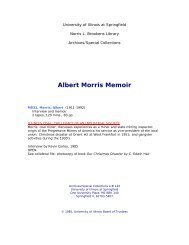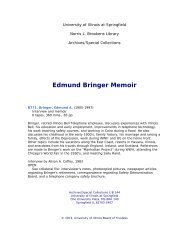<strong>Gerald</strong> W. Mth 232is no relevance to facts or regard to it. So that was an interestingitem.I might also say that it was an interesting topic, which leads me now toone that I am going to add to my notes. In talking about tuition chargeper capita and levels of cost, I am reminded that the act also stipulatedthe level of state apportionment for the junior colleges as it came outwhich was for the first year $11.50 per semester hour credit, for . . .QThat was across the board.A. Yes. This was the state apportionment: $11.50 for all colleges, theexisting colleges and the new ones. It stipulated then that after the firstyear that was to be $11.50 for the new colleges and $9.50 for the existingcolleges. Now, the master plan stipulated approximately 50 percent of thecost of operating the colleges should come fmm state revenue and yet wecame up with only $11.50 per semester hour credit and there is a matterthat ought to be spoken to with regard to that. In attempting to arriveat a figure to write into the specific act, it was very difficult to determinewhat the average semester-how costs for operating Illinois juniorcolleges really were. And this grew out of the circumstances of the day.Black Hawk College was the only institition operating as a separate orautonornus institution. I had been doing so for three years. Each ofthe other colleges was a part of a school district and their accountbgsystems were far from uniform. They were almost, each of them, indiwfdual.So these were the circumstances as we tried to compute the average percapita cost. A few of the existing colleges that were operating in connectionwith townships or community high schools were operating with accountingsystems that revealed very clearly the cost of operating the 13th and14th years. There was a specific accounting procedure that took in all theelements, so for two or three of them there were very excellent data. Insome of the cornunity colleges the accounting procedures covered pades 9through 14 with no buleak-out at'all for any of the 6 years that were inthat institution and it was very difficult to arrive at my specific ffgwesfor the jwLfor college operation of it. And then there were a few omu unitycolleges didn't cost very mch. And so they were saying, for example, thatwe would be heating the building, we would be light% the building, wewould be providing mintenance on the building, we would have custodialservices, we would do a11 those thin@$ whether the high school or tqe communitycollege was here or not. And so their accounting really in Tactassigned a disproportionate share of the cost of the high school opq~ationand displayed a very small cost to the operation of the junior college.Q. You believe what you want to belleve.4IA. Yes. I'm not willing to stick neck out here and identify th se institutionslaut I could do so, I could give examples if you wanted to,but in all fairness to these people, I'm not going to. Well, as yo seethis made a very difficult thing. So the interesting thing is that althoughwe lmew that the $11.50 was a low figure for state financing on the basisof 50 percent of the opeating costs, in terms of documentation we didn'thave any thing better to give. I'm talking about the Association of CbmmunityOolleges, I'm talking about the research of the Board of Higher
<strong>Gerald</strong> W. <strong>Smith</strong> 2 3Education; I'm talking about the support of the Chamber of Comrcethe I1lhois Tax Payers Federation Association and so forth. All ofwere involved in this klnd of thing, the Illinois Educatfon Associaexcellent reseamh depwtment. These were the best we could come upI thlnk this ought to be explained in there, and it points out thatfrom the day that the act passed, the new colleges as they came intotence began to argue that the level of state support was too low andtainly substantially below the 50 percent level.ndusionf swith.almostexiscer-END OF TAPE TWELVE SIDE TWOQ. So, Gerry, I think you are probably at the poht where you are wadyto talk about point 1.A. Yes. With regad to the Act itself, the subject here relates to thecharge back, or the payment of tuition, or a portion of the tuition forout-of-district students 5r-1 the junior callege districts. You will pcallin speaking about the Wter Plan that the observation had been made thatthe Master Plan proposed that all citizens of Illinois, regardless of theirplace of residence be entitled to attend a public conarnnnity college, and,to have a portlon of that cost paid by local taxes.And, SO, when the Act was passed it had two provisions in this direction.F'irst of all, it provided that if a student lived in a c d t y coldistrict, and desired to and was eligible to follow a program notin the ham district, that student could then attend a junior collee insome other part of the State that offered that program and have a portionof the cost paid by the h m district. So there was this reciprocitybetween districts and the guarantee that...that all citizens of Illinoiswere eligible to take part fn programs in cormunity colleges wherever theywere. Even going from one home district to another if that pmpam wasnot available in the home district.Tne other facet had to do with those people whose residence was not In ajunior college district which are, in just popular language, labelednon-junior college territo ry.... or non-junior college district. You won'tfhd that language in the statutes. 'That was the popular language weused. And...again, this Act then as it came out, provided a procedure bywhich the residents of these out-of-district areas could select a collegeof their choice and seek reinbursent for a portion of their costs fmrntheir home camsnunity. It turned out that the admhistrative agency forhandling this, to which I have previously referred, was the school dPstrictwhich operated the hi& school. If they lived in a township or cohigh school district that's where they went; if they lived in a unit dis-T:mtrict then, of course, they went to the office of the unit district.they filed a statement of intent to go to the junior college which innediatelycamltted that district to bear that port;ion of the cost and thenuponenrolbent and proper certification by the college that the student attended,the local district could be billed to pay that tuition on the basis of atax whfch the district was authorized to charge.
- Page 1 and 2: University of Illinois at Springfie
- Page 3 and 4: Gerald W. Smith 201A. I would like
- Page 5 and 6: Gerald W. Mth 20 3One of the outcom
- Page 7 and 8: Gerald W. Smith 20514-Ipeople who h
- Page 9 and 10: Gerald W. Wth 207Master Plan and th
- Page 11 and 12: Gerald W.Smithof them have retired.
- Page 13 and 14: Gerald W. Smith 211Q. There was lot
- Page 15 and 16: Gerald W. Sr~Lth 2131As a counte~pr
- Page 17 and 18: Gerald W. Smith215IWge tuition at o
- Page 19 and 20: Gerald W.SmithA. And m n I'll speak
- Page 21 and 22: Gerald W. Smith 219to continue with
- Page 23 and 24: Gerald W. Smith 221A. The principal
- Page 25 and 26: Gerald W.SmithQ. And who was it tha
- Page 27 and 28: Gerald W. SMth 225who was skilled o
- Page 29 and 30: Gerald W. Smith 227A. Generally spe
- Page 31 and 32: Gerald W. mth 2 29climate fop it. B
- Page 33: Gerald W. Smith 2 31discuss this as
- Page 37 and 38: Gerald W.Smlth23Fjbut we would say
- Page 39 and 40: Gerald W. Smith 237point out that i
- Page 41 and 42: For example, when they met on the a
- Page 43 and 44: Gerald W. Smith 241Hawk Cammity Col
- Page 45 and 46: Gerald W. Smith 243was there wlth a
- Page 47 and 48: Gerald W. Smith 245The following is
- Page 49 and 50: 1people who were working wfth me a
- Page 51 and 52: Gerald W. Smith 249I was looking in
- Page 53 and 54: Gerald W. Smith 251.developnents ea
- Page 55 and 56: Gerald W. Smith 253Secretm for the
- Page 57 and 58: Gerald W. Smith 255He and I then wo
- Page 59 and 60: Gerald W. Smith 257One of the peopl
- Page 61 and 62: Gerald W.Smith259we always indicate
- Page 63 and 64: Gerald W. Smith26rCentralia, 1940;M
- Page 65 and 66: Gerald W.SmithJdor College Act ax i
- Page 67 and 68: Gerald W. Smith 265districts, also
- Page 69 and 70: Gerald W. Smith 267A. Yes, I think
- Page 71 and 72: Q. That's an unbelievable record.A.
- Page 73 and 74: So this is the story of Danville. I
- Page 75 and 76: Gerald W. Smith 2 73Of course, you
- Page 77 and 78: At the far south, a junlor college
- Page 79 and 80: Gerald W. Smith 2 77FIe ad, In fact
- Page 81 and 82: me, but he was not happy about it t
- Page 83 and 84: Gerald W. Smith 281Q. Let me ask ya
- Page 85 and 86:
not understanding the le@slative pr
- Page 87 and 88:
Gerald W. Mth 2 85I tbhk it 2s inte
- Page 89 and 90:
Gerald W. Smith 287Board received a
- Page 91 and 92:
Gerald W. Smith 2 89land they were
- Page 93 and 94:
Gerald W. Smith 291Q. Now there was
- Page 95 and 96:
Q. Was there sane particular reason
- Page 97 and 98:
At any rate, it was a year before t
- Page 99 and 100:
A. Yes. He was the prbe mver and le
- Page 101 and 102:
Gerald W. Smith 9opportunity to org
- Page 103 and 104:
Gerald W. Wth 30 1of Cook County is
- Page 105 and 106:
A. ... even though the statutes pre
- Page 107 and 108:
Gerald W. Wth 30 5who actually, as
- Page 109 and 110:
Gerald W. Smith 30 7Their feasibili
- Page 111 and 112:
Gerald W.Wth309There were two quota
- Page 113 and 114:
Gerald W, Smith. -The referendum fo
- Page 115 and 116:
Gerald W. Smith 31 3In the Galesbur
- Page 117 and 118:
Gerald W.Smith315Q. This is perhaps
- Page 119 and 120:
Gerald W. Smith 317proposal - just
- Page 121 and 122:
Gerald W. Smith 319I would poht out
- Page 123 and 124:
Gerald W.Smith321$0 they were to go
- Page 125 and 126:
They enunciated a pollcy that was n
- Page 127 and 128:
Gerald FI, Wth325A. I have never se
- Page 129 and 130:
Gerald W. Wth 32 7A. Yes, the count
- Page 131 and 132:
Gemld W. Smith 329A. Well, yes, I a
- Page 133 and 134:
Q. This is a continuation of the in
- Page 135 and 136:
Gerald W. Smith 333were workin@; to
- Page 137 and 138:
Gerald W. Smith 335perhaps to take
- Page 139 and 140:
Gerald W. Smith 337'Rut north in Un
- Page 141 and 142:
Gerald W. Smith 339A. Speaking now
- Page 143 and 144:
Gerald W. Smith 341A. Well they are
- Page 145 and 146:
Gerald W. Smith 343opportunity to d
- Page 147 and 148:
Gerald W. Smith 341This district wa
- Page 149 and 150:
Gerald W. Smith 34 7When Cahokia pe
- Page 151 and 152:
Gerald W. Smith 349Q. This is tape





